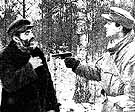
|
|
|

|

|

|

|
|
Click on an image to see a larger, more detailed picture.
|
|
|
|
|
| 1943: Death and Resistance |

|
pg. 485 |

|
|
|
|
| |
 Moshe Gildenman, also known as "Uncle Misha," commanded a partisan unit in the Ukraine. After the Nazis killed his wife and daughter on May 21, 1942, Gildenman and his surviving son formed a rebel group that attacked German farms and Ukrainian police centers. When his unit was incorporated into a general partisan group in 1943, Moshe volunteered for the Soviet Army. He emigrated to Israel in 1950 and died in 1958.
Moshe Gildenman, also known as "Uncle Misha," commanded a partisan unit in the Ukraine. After the Nazis killed his wife and daughter on May 21, 1942, Gildenman and his surviving son formed a rebel group that attacked German farms and Ukrainian police centers. When his unit was incorporated into a general partisan group in 1943, Moshe volunteered for the Soviet Army. He emigrated to Israel in 1950 and died in 1958.
Photo: United States Holocaust Memorial Museum Photo Archive
|
 Seeking to prevent people from fleeing the Minsk (Belorussia) Ghetto for the forests, this bilingual sign warns against climbing through a fence. Although the penalty was death, many in the ghetto took the risk. Guided by daring children, some as young as 11, entire families sought safety in the forest, where many joined the family camp and partisan unit of Shalom Zorin.
Seeking to prevent people from fleeing the Minsk (Belorussia) Ghetto for the forests, this bilingual sign warns against climbing through a fence. Although the penalty was death, many in the ghetto took the risk. Guided by daring children, some as young as 11, entire families sought safety in the forest, where many joined the family camp and partisan unit of Shalom Zorin.
Photo: Yad Vashem
|
 Near Minsk, Belorussia, a German soldier aims his pistol at a Jew, perhaps suspecting him to be a partisan. Following the deportation of 4000 Jews from Minsk in October 1943, only the few Jews who had managed to hide remained in the ghetto. Beginning in spring 1942 many had fled the ghetto for the surrounding forests, where they joined partisan groups such as the Shalom Zorin unit, which eventually included 800 fighters.
Near Minsk, Belorussia, a German soldier aims his pistol at a Jew, perhaps suspecting him to be a partisan. Following the deportation of 4000 Jews from Minsk in October 1943, only the few Jews who had managed to hide remained in the ghetto. Beginning in spring 1942 many had fled the ghetto for the surrounding forests, where they joined partisan groups such as the Shalom Zorin unit, which eventually included 800 fighters.
Photo: Yad Vashem
|
|

|

|

|

|
 October 2, 1943: The Danish people rescue about 7000 Jews, only 500 of whom are captured by the Germans. The 500 seized by the Germans are sent to the Theresienstadt, Czechoslovakia, camp/ghetto; all but 77 will survive the war. The Danish government will persistently check on the health and welfare of the Jews who were sent to Theresienstadt, enabling almost all of them to survive to war's end.
October 2, 1943: The Danish people rescue about 7000 Jews, only 500 of whom are captured by the Germans. The 500 seized by the Germans are sent to the Theresienstadt, Czechoslovakia, camp/ghetto; all but 77 will survive the war. The Danish government will persistently check on the health and welfare of the Jews who were sent to Theresienstadt, enabling almost all of them to survive to war's end.
|
 October 2, 1943: The first Jewish Palestinian paratroopers land in the Balkans. These Jews agree first to help organized non-Jewish underground units on behalf of the British war effort. Only then, unsupported, will the British allow them to aid other Jews.
October 2, 1943: The first Jewish Palestinian paratroopers land in the Balkans. These Jews agree first to help organized non-Jewish underground units on behalf of the British war effort. Only then, unsupported, will the British allow them to aid other Jews.
|
 October 2-3, 1943: In Holland, the families of Jewish men drafted for forced labor are sent to the Westerbork, Holland, concentration camp.
October 2-3, 1943: In Holland, the families of Jewish men drafted for forced labor are sent to the Westerbork, Holland, concentration camp.
|
 October 3, 1943: On a routine barracks inspection at the Auschwitz-Birkenau death camp, an SS doctor judges 139 inmates unfit to work. These inmates are promptly gassed.
October 3, 1943: On a routine barracks inspection at the Auschwitz-Birkenau death camp, an SS doctor judges 139 inmates unfit to work. These inmates are promptly gassed.
|
|
|
|
|
| 1943: Death and Resistance |

|
pg. 485 |

|
|
The Holocaust Chronicle
© 2009 Publications International, Ltd.
|
|
